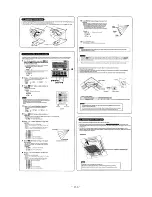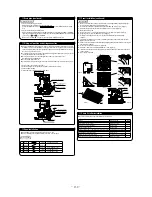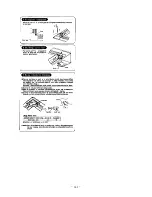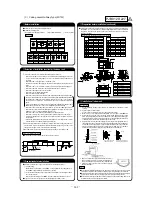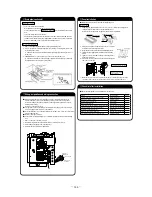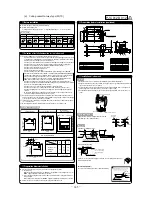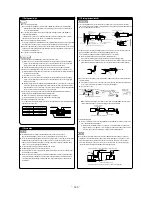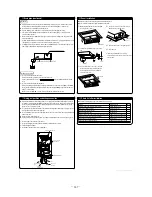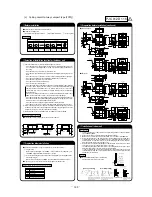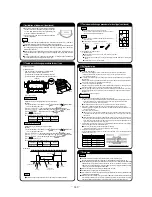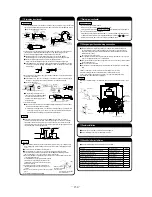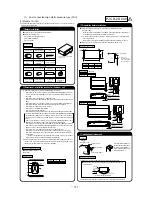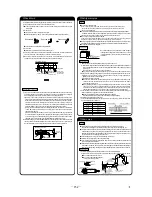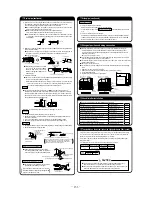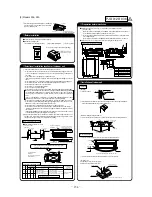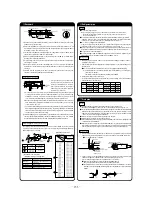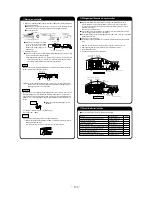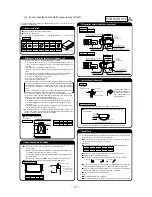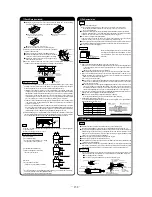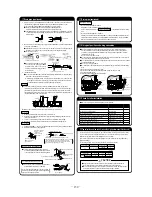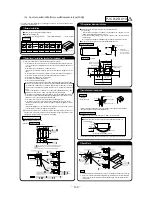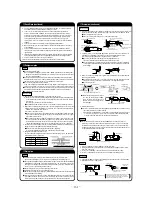
-
150
-
④
Installation of indoor unit (continued)
⑤
The indoor unit change procedure for duct type
Prepare a duct panel.
(1) Drill hole for duct
①
While referring to the dimensions, cut the insulation.
②
Cut sheet metal for the hole, and drill hole.
③
Install the duct joint with screws attached to the panel.
④
Install the bottom plate with screws attached to the panel.
⑤
Set up as follows:
Changing the fan tap
Change the fan tap to the high speed by the remote controller.
[Method]
①
Stop the operation of air conditioner. Press (SET) button and (MODE) button
for 3 seconds at the same time.
②
Select “ ” (Indoor Unit Function) and press (SET) button.
③
Select “ ” (Fan Speed Setting) of No.”02” and press (SET) button.
④
Select “ ” (High Fan Speed 1) and press (SET) button.
⑤
Press button to exit.
As for details, refer to the installation manual of remote controller.
Invalidating the louver switch
Invalidate the louver switch by the remote controller.
[Method]
①
Stop the operation of air conditioner. Press (SET) button and (MODE) button
for 3 seconds at the same time.
②
Select “ ” (Remote Controller Function) and press (SET) button.
③
Select “ ” (Louver Switch Setting) of No. “07” and press (SET) button.
④
Select “ ” (Louver Switch Invalid) and press (SET) button.
⑤
Press button to exit.
As for details, refer to the installation manual of remote controller.
(2) Duct work
Request
●
Calculate air flow and the static pressure to select the duct’s length and shape.
Indoor unit
Hose
⑥
Refrigerant pipe
⑦
Drain pipe
Caution
●
Use the new refrigerant pipe.
When re-using the existing pipe system for R22 or R407C, pay attention to the following items.
・
Change the flare nuts with the attached ones (JIS category 2), and reprocess the flare parts.
・
Do not use thin-walled pipes.
●
Use phosphorus deoxidized copper alloy seamless pipe (C1220T specified in JIS H3300) for refrigeration
pipe installation.
In addition, make sure there is no damage both inside and outside of the pipe, and no harmful substances
such as sulfur, oxide, dust or a contaminant stuck on the pipes.
●
Do not use any refrigerant other than R410A.
Using other refrigerant except R410A (R22 etc.) may degrade inside refrigeration oil. And air getting into
refrigeration circuit may cause over-pressure and resultant it may result in bursting, etc.
●
Store the copper pipes indoors and seal the both end of them until they are brazed in order to avoid any
dust, dirt or water getting into pipe. Otherwise it will cause degradation of refrigeration oil and compressor
breakdown, etc.
●
Use special tools for R410 refrigerant.
Work procedure
1. Remove the flare nut and blind flanges on the pipe of the indoor unit.
※
Make sure to loosen the flare nut with holding the nut on pipe side with a spanner and giving torque to the nut
with another spanner in order to avoid unexpected stress to the copper pipe, and then remove them.
(Gas may come out at this time, but it is not abnormal.)
●
Pay attention whether the flare nut pops out. (as the indoor unit is sometimes pressured.)
2. Make a flare on liquid pipe and gas pipe, and connect the refrigeration pipes on the indoor unit.
※
Bend the pipe with as big radius as possible and do not bend the pipe repeatedly. In addition, do not
twist and crush the pipes.
※
Do a flare connection as follows:
●
Make sure to loosen the flare nut with holding the nut on pipe side with a spanner and giving torque
to the nut with another spanner in order to avoid unexpected stress to the copper pipe, and then
remove them.
●
When fastening the flare nut, align the refrigeration pipe with the center of flare nut, screw the nut for
3-4 times by hand and then tighten it by spanner with the specified torque mentioned in the table
below. Make sure to hold the pipe on the indoor unit securely by a spanner when tightening the nut in
order to avoid unexpected stress on the copper pipe.
3. Cover the flare connection part of the indoor unit with attached insulation material after a gas leakage
inspection, and tighten both ends with attached straps.
●
Make sure to insulate both gas pipes and liquid pipes completely.
※
Incomplete insulation may cause dew condensation or water dropping.
4. Refrigerant is charged in the outdoor unit.
As for the additional refrigerant charge for the indoor unit and piping, refer to the installation manual
attached to the outdoor unit.
Caution
●
Install the drain pipe according to the installation manual in order to drain properly.
Imperfection in draining may cause flood indoors and wetting the household goods, etc.
●
Do not put the drain pipe directly into the ditch where toxic gas such as sulfur, the other harmful and
inflammable gas is generated. Toxic gas would flow into the room and it would cause serious
damage to user’s health and safety (some poisoning or deficiency of oxygen). In addition, it may
cause corrosion of heat exchanger and bad smell.
●
Connect the pipe securely to avoid water leakage from the joint.
●
Insulate the pipe properly to avoid condensation drop.
●
Check if the water can flow out properly from both the drain outlet on the indoor unit and the end
of the drain pipe after installation.
●
Make sure to make descending slope of greater than 1/100 and do not make up-down bend and/or trap
in the midway. In addition, do not put air vent on the drain pipe. Check if water is drained out properly
from the pipe during commissioning. Also, keep sufficient space for inspection and maintenance.
⑦
Drain pipe (continued)
Work procedure
1. Insert the supplied drain hose (the end made of soft PVC) to the step of the drain socket on the indoor unit
and fix it securely with the clamp.
Attach the hose clamp to the drain hose around 10mm from the end.
●
Do not apply adhesives on this end.
⑦
Drain pipe (continued)
⑧
Wiring-out position and wiring connection
⑨
Panel installation
⑩
Check list after installation
Drain pump operation
○
In case electrical wiring work finished
Drain pump can be operated by remote controller (wired).
For the operation method, refer to Operation for drain pump in the installation manual for wiring work.
○
In case electrical wiring work not finished
Drain pump will run continuously when the dip switch“SW7-1” on the indoor unit PCB is turned ON, the Connec-
tor CNB is disconnected, and then the power supply (220-240VAC on the terminal block
L
and
N
) is turned
ON. Make sure to turn OFF “SW7-1” and reconnect the Connector CNB after the test.
●
Electrical installation work must be performed according to the installation manual by an
electrical installation service provider qualified by a power provider of the country, and be
executed according to the technical standards and other regulations applicable to electrical
installation in the country.
Be sure to use an exclusive circuit.
●
Use specified cord, fasten the wiring to the terminal securely, and hold the cord securely in
order not to apply unexpected stress on the terminal.
●
Do not put both power source line and signal line on the same route. It may cause miscommu-
nication and malfunction.
●
Be sure to do D type earth work.
●
For the details of electrical wiring work, see attached instruction manual for electrical wiring
work.
1. Remove a lid of the control box (2 screws) and the wiring cover (2 screws).
2. Hold each wiring inside the unit and fasten them to terminal block securely.
3. Take out the wiring to upper direction of wiring cover, and fix the wiring with clamp.
4. Install the removed parts back to original place.
Caution
Make sure to install the wiring cover. Otherwise it may cause dew condensation into the control
box.
●
Attach the panel on the indoor unit after electrical wiring work.
●
Refer to attached manual for panel installation for details.
●
Check the following items after all installation work completed.
6. Make sure to install the indoor unit horizontally. Confirm the
levelness of the indoor unit with a level gauge or transpar-
ent hose filled with water. Keep the height difference at
both ends of the indoor unit within 3mm.
7. Tighten four upper nuts and fix the unit after height and
levelness adjustment.
Caution
●
Do not adjust the height by adjusting upper nuts. It will cause unexpected stress on the indoor
unit and it will lead to deformation of the unit, failure of attaching a panel.
●
Make sure to install the indoor unit horizontally and set the gap between the unit underside and
the ceiling plane properly. Improper installation may cause air leakage, dew condensation,
water leakage and noise.
●
Make sure there is no gap between decoration panel and ceiling surface, and between decora-
tion panel and the indoor unit. The gap may cause air leakage, dew condensation and water
leakage.
●
In case decorative panel is not installed at the same time, or ceiling material is installed after
the unit installed, avoid dust coming into the indoor unit.
CATEGORY
NUMBER
FUNCTION
SETTING
02
CATEGORY
NUMBER
FUNCTION
SETTING
07
⑤
The indoor unit change procedure for duct type (continued)
Caution
●
Take care that the static pressure does not exceed 30 Pa.
The indoor unit has condensation owing to the decrease of air flow, may
cause wetting the ceiling and household goods.
Request
●
The duct should be minimum bends. (Make the bend radius as
large as possible.)
●
Conduct the duct work before ceiling attachment.
(3) Connecting duct for outside air intake
①
Outside air intake
●
Use the intake, which is easier for work, either at the rear or the side.
②
Duct connection
●
Connect the 125 mm diameter duct, using the duct flange for 125mm diameter duct. (Clamp with
band)
●
Insulate the duct to prevent condensation.
Pipe cover (small)
(For insulation) (Accessory)
Pipe cover
(For insulation)
(Prepare on site)
Unit
Pipe cover (big)
(For insulation) (Accessory)
VP-20
(Prepare on site)
Joint for VP-20
(Prepare on site)
VP-25
(Prepare on site)
Drain hose (Accessory)
Drain socket
Clamp (Accessory)
(No adhesive allowed)
Unit
Pipe cover (small)
(For insulation) (Accessory)
Pipe cover (For insulation)
(Prepare on site)
Pipe cover (big)
(For insulation)
(Accessory)
VP-20
(Prepare on site)
Joint for VP-20
(Prepare on site)
Drain hose
(Accessory)
Drain socket
Drain socket
The step part
Drain hose
Clamp (Accessory)
Connect
No adhesive allowed
Wiring input port
Control box
Wiring cover
Wiring cover
Clamp
Wiring
CNU
Earth
Indoor power
source line
Remote controller line
Signal line (Shielded cord)
Signal side
terminal block
Power source side
terminal block
Earth
(Signal line)
Pipe diameter
Tightening torque N·m
φ
6.35
φ
9.52
φ
12.7
φ
15.88
φ
19.05
14 to 18
34 to 42
49 to 61
68 to 82
100 to 120
Strap (Accessory)
Pipe cover (Accessory)
The thickness of insulation should be 20mm or more.
L
L
N
N
Fasten the screw securely
Hose clamp
Drain hose
Drain socket
Metal plate
10mm
C
C
C
C
C
C
C
C
C
C
C
C
C
C
C
C
C
C
C
C
C
C
C
C
C
C
C
C
Outlet
Cut.
Duct joint
Bottom plate
Control Box
[Upward]
40
80
100
155
27
27
37
20
150
150
490
30
150
20
30
40 45
120
120
45 40 40
Indoor unit
Selling surface
Air supply
Supply air duct
(Prepare on site)
Insulate duct
Air return
Bad example
Bad example
Good example
50
6.5
7
7.5
7.8
40
30
20
10
0
Upper limit
Upper limit
High
Low
Air flow (m
3
/min)
Static pressure (Pa)
2. Prepare a joint for connecting VP-20 pipe, adhere and connect the joint to the drain hose
(the end made of rigid PVC), and adhere and connect VP-20 pipe (prepare on site).
※
As for drain pipe, apply VP-20 made of rigid PVC which is on the market.
●
When drain pipe is set to rising in the nearest of the unit, use the VP-20 pipe.
When drain pipe is set to after the horizontal pulling, use the VP-25 and above pipe.
●
Make sure that the adhesive will not get into the supplied drain hose.
It may cause the flexible part broken after the adhesive is dried up and gets rigid.
●
The flexible drain hose is intended to absorb a small difference at installation of the unit
or drain pipes. Intentional bending, expanding may cause the flexible hose broken and
water leakage.
3. Make sure to make descending slope of greater than 1/100 and do not make up-down bend
and/or trap in the midway.
●
Pay attention not to give stress on the pipe on the indoor unit side, and support and fix
the pipe as close place to the unit as possible when connecting the drain pipe.
●
Do not set up air vent.
●
When sharing a drain pipe for more
than one unit, lay the main pipe 100mm
below the drain outlet of the unit. In
addition, select VP-30 or bigger size for
main drain pipe.
Supporting metal
No bump
No trap
Not touching the water
Trapped air will
generate noises.
Air vent
Insulation material
1.5m ~ 2m
Descending slope greater than 1/100
Descending slope greater than 1/100
VP-30 or bigger
As wide as possible
(about100mm)
Over 20mm
4. Insulate the drain pipe.
●
Be sure to insulate the drain socket and rigid PVC pipe installed indoors otherwise it may
cause dew condensation and water leakage.
※
After drainage test implementation, cover the drain socket part with pipe cover (small size), then
use the pipe cover (big size) to cover the pipe cover (small size), clamps and part of the drain
hose, and fix and wrap it with tapes to wrap and make joint part gapless.
Drain up
●
The position for drain pipe outlet can be raised up to 600mm above the ceiling. Use elbows for
installation to avoid obstacles inside ceiling. If the horizontal drain pipe is too long before vertical pipe,
the backflow of water will increase when the unit is stopped, and it may cause overflow of water from
the drain pan on the indoor unit. In order to avoid overflow, keep the horizontal pipe length and offset of
the pipe within the limit shown in the figure below.
Drain test
●
After installation of drain pipe, make sure that drain system work in good condition and no
water leakage from joint and drain pan. Check if the motor sound of drain pump is normal
or not.
●
Do drain test even if installation of heating season.
●
For new building cases, make sure to complete the test before hanging the ceiling.
1. Remove the drain grommet, and pour water of about 1000cc into the drain pan in the
indoor unit by pump so as not to get the electrical component wet.
2. Make sure that water is drained out properly and there is no water leakage from any joints
of the drain pipe at the test.
Confirm that the water is properly drained out while
the drain motor is operating. At the drain socket
(transparent), it is possible to check if the water is
drained out properly.
3. Unplug the drain plug on the indoor unit to remove
remaining water on the drain pan after the test, and
re-plug it.
4. Make sure to install the grommet back to original
place.
5. Insulate the drain pipe properly finally.
600mm or less
Joint for VP-20 (Prepare on site)
295 to 325mm
100mm or less
Pump
Remove grommet
Make sure to install
it back after test.
Insert the edge of water pump
hose in the drain pan.
Check if
Expected trouble
Check
The indoor and outdoor units are fixed securely?
Falling, vibration, noise
Inspection for leakage is done?
Insufficient capacity
Insulation work is properly done?
Water leakage
Water is drained properly?
Water leakage
Supply voltage is same as mentioned in the model name plate?
PCB burnt out, not working at all
There is mis-wiring or mis-connection of piping?
PCB burnt out, not working at all
Earth wiring is connected properly?
Electric shock
Cable size comply with specified size?
PCB burnt out, not working at all
Any obstacle blocks airflow on air inlet and outlet?
Insufficient capacity
PJC012D116
B
Summary of Contents for FDE112KXE6A
Page 104: ... 102 ...
Page 111: ... 108 b Ceiling cassette 4 way Compact type FDTC Models All moddels B PJA003Z331 ...
Page 112: ... 109 c Ceiling cassette 2 way type FDTW Models FDTW28KXE6 45KXE6 56KXE6 B PJB001Z560 ...
Page 113: ... 110 Models FDTW71KXE6 90KXE6 B PJB001Z561 ...
Page 114: ... 111 Models FDTW112KXE6 140KXE6 B PJB001Z562 ...
Page 115: ... 112 d Ceiling cassette 1 way type FDTS Model FDTS45KXE6 A PJC001Z195 ...
Page 116: ... 113 Model FDTS71KXE6 A PJC001Z196 ...
Page 117: ... 114 e Ceiling cassette 1 way compact type FDTQ Models All models A PJC001Z190 ...
Page 118: ... 115 Models All models Duct panel A PJC001Z240 ...
Page 121: ... 118 Models FDU224KXE6 280KXE6 B PJD001Z230 ...
Page 123: ... 120 Models FDUM112KXE6 140KXE6 B PJR002Z259 ...
Page 124: ... 121 h Duct connected Ultra thin Low static pressure type FDQS Models All models C PJC001Z200 ...
Page 125: ... 122 i Wall mounted type FDK Models FDK22KXE6 28KXE6 36KXE6 45KXE6 56KXE6 B PHA000Z983 ...
Page 126: ... 123 Models FDK71KXE6 B PHA000Z984 ...
Page 127: ... 124 j Ceiling suspended type FDE Models FDE36KXE6A 45KXE6A 56KXE6A B PFA003Z826 ...
Page 128: ... 125 Models FDE71KXE6A 112KXE6A 140KXE6A B PFA003Z827 ...
Page 129: ... 126 k Floor standing with casing type FDFL Models All models B PGD000Z053 ...
Page 130: ... 127 l Floor standing without casing type FDFU Models All models A PGD000Z058 ...
Page 131: ... 128 m Duct Connected Compact and Flexible type FDUH Models All models A PJC001Z255 ...
Page 138: ... 135 ...
Page 139: ... 136 ...
Page 143: ... 140 b ...
Page 144: ... 141 ...
Page 191: ... 188 5 4 Installation of outdoor unit ...
Page 193: ... 190 ...
Page 194: ... 191 ...
Page 195: ... 192 ...
Page 196: ... 193 ...
Page 197: ... 194 ...
Page 198: ... 195 ...
Page 199: ... 196 ...
Page 200: ... 197 ...
Page 201: ... 198 ...
Page 202: ... 199 ...
Page 203: ... 200 ...
Page 204: ... 201 ...
Page 205: ... 202 ...
Page 206: ... 203 ...
Page 207: ... 204 ...
Page 208: ... 205 ...
Page 210: ... 207 ...
Page 211: ... 208 ...
Page 212: ... 209 ...
Page 215: ... 212 2 model type DIS model type HEAD ...
Page 216: ... 213 2 2 ...
Page 217: ... 214 2 2 2 2 2 ...

